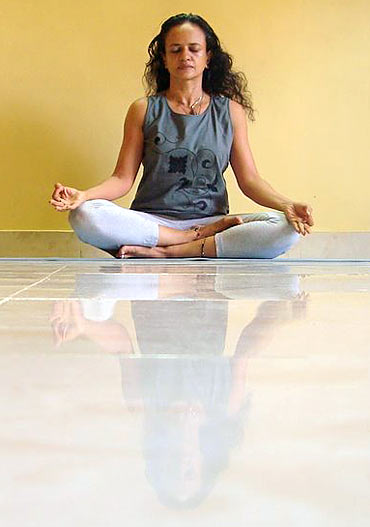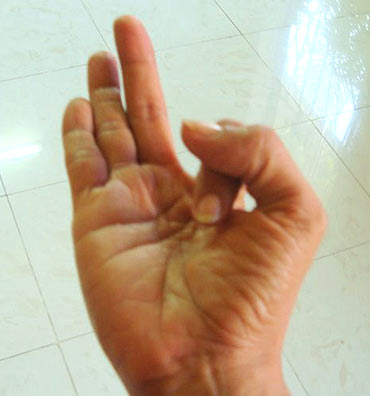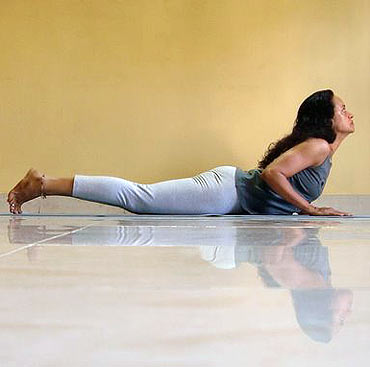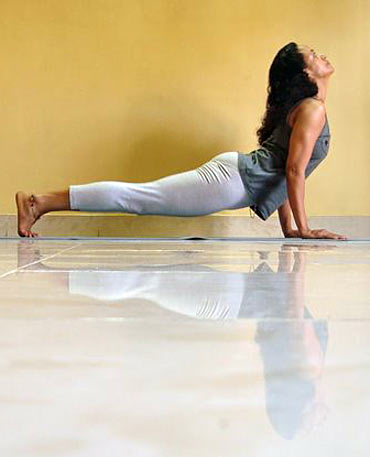
Singers and performers know well that voice must be trained to be able to use it effectively. What most of us do not know is this: That voice can also age and lose its texture if it is not trained. In yoga certain practices help retain the integrity of the voice and also helps us control our communication skills better.
Poses that massage the neck powerfully such as most of the backbends belong to this category. Also pranayamas or breathing practices where the positive stress of that practice is on the voice box -- such as the humming bee pranayama (or bhramari) and the victory breath (ujjayi).
Mudras that increase the water element in the body, such as jal mudra (water hand gesture) help to treat dryness of the throat. Similarly Vayu Shaamak (hand gesture to control the air element) helps with sore throat. During congestion, mudras which create the opposite effect, such as surya mudra (sun hand gesture) would be effective.
Apart from the above mentioned pranayamas, most others also help with voice throw and control because they fine-tune your breathing and help control exhalation, during which actually we speak or sing. Control of exhalation is an important feature in voice control and that is the main focus of most yogic breathing practices.
Here Shameem Akthar, yoga acharya trained with the Sivananda Yoga Vedanta Center, Kerala, shows you five practices that will help improve the texture of your voice.
For more of Shameem's yoga writings visit http://jaisivananda.blogspot.com. Follow Shameem's yoga products on her online shop Yogatique on Rediff Shopping here.
Disclaimer: This column just shares the columnist's passion for yoga which is ideally learned under the guidance of an expert.

To do this pose, also referred to as parvatasana or mountain pose, kneel down. Lean forward to place palms flat on ground in front. Exhale. Hoist hips off the floor, pushing down shoulders as you continue breathing, making following adjustments. Push down heels.
Focus attention on stomach. Apply pressure from shoulder blades. Move head as close to the ground as possible. Hold the pose as long as you can. Do this several times initially. Later, build up the stamina to hold pose for a minute or so.
Benefits: Is a powerful stamina-builder. Boosts calmness due to blood flow to brain. Balances blood pressure: Both low and high. Alleviates all spinal problems. Tones arms and legs. Entire body is worked out. Removes wrinkles.

Sit in any meditative practice. Shut eyes, hands in any mudra or hand gesture of your choice -- ideally tips of index fingers and thumb in each hand touching.
Inhale gently, from the throat. The sound must be gentle, like light snoring of a baby, without any strain. Exhale in similar fashion. This is one round.
Do nine rounds. After regular practice, you may inhale deep and long and exhale to double the length of your inhalation. This comes only with guidance and regular practice.
Avoid: In extreme cases of depression and low blood pressure.
Benefits:
The soft pressure at the throat works the vagus nerve, the powerful parasympathetic nerve that wanders over most of the body. This impacts the entire body, entering it into a rejuvenating, repairing mode.
The parasympathetic system is switched on when the body gets into a relaxed state: So this breathing technique induces it, and helps bring emotional and mental equilibrium back to the body.

Sit meditatively, eyes shut. Press down index and middle fingers firmly with thumb. Do for each hand. Hold for three to five minutes. Release.
Benefits:
Controls nervous tension; relieves dryness of eyes, skin and hair. Promotes metabolism. Sweetens voice. Again used as therapy for pain caused by dry joints, arthritis, and degenerating tissue.

Lie on stomach with chin on floor and palms either side of shoulder. Inhale. Raise chin and shoulder off the floor arching back. Eyes should look up at the ceiling, stomach should remain pressed on the floor so the arch is emphasised at the lower back.
Hold for a few seconds initially. Breathe normally throughout. To return to starting position, exhale and lower back gently to the floor. Attempt thrice. With a few weeks or even months of practice, you can do this pose only once but extend time to half a minute or more in the final position.
Avoid: In case of abdominal inflammations and flare-ups and severe lower backache and hyper-thyroidism.
Benefits: Same as above. It also helps with weight-loss due to pressure on thyroid at throat. Therapeutic value in diabetes due to pressure on abdomen.

Lie on your stomach. Chin on the floor, palms flat on the ground on either side of your waist. Top of your feet should be flat on the floor. Inhale, pushing down your palms and pushing yourself off the floor, so the torso lifts off as well as your knees, as shown in the photograph.
Look ahead or overhead, keeping the torso straight ahead. Continue normal breathing. Hold position as long as is possible. Exhale and release gently back to the starting position.
Avoid: If having wrist problems or headache.
Point to note: This is an advanced variation of the cobra and needs wrist strength and muscular stamina and may hence be attempted only by those who have done regular exercise.
Benefits: Same as above, though enhanced. Builds mental and muscular stamina.